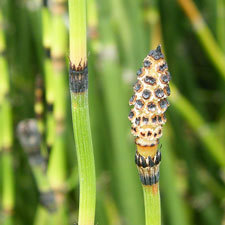 Rough horsetail
Rough horsetail
Common name: Rough horsetail
Botanical name: Equisetum hyemale
Management category: Sustained control - Rule 5a applies
Native to North America, Europe and northern Asia it is actually part of a “living fossil” species which has grown for over 100 million years. Introduced to New Zealand as an ornamental plant, especially for aquatic habitats.
Why is it a pest?
- Toxic to stock.
- Difficult to control as herbicide has difficulty penetrating into the extensive rhizome system.
- Hard to dig out as all rhizome fragments need to be removed to prevent regrowth.
- Forms dense stands through rhizomes spreading underground and sprouting new plants.
- Encourages sedimentation as the plant forms dense stands and can alter water courses.
Where is it found?
- Primarily found in wetlands, lakes, ponds, springs and water courses.
- Three sites are being managed in Tauranga. Not known to be elsewhere in Bay of Plenty.
What does it look like?
- Can grow up to 1.2m high.
- Stems are hollow.
- It does not produce flowers, instead, spores are concentrated at the tip of the stem in an asparagus like head.
- Rhizomes can grow to 1m deep in the soil, making digging the plant out very tricky.
What are the rules?
Sustained control
Sustained Control pests are well established in the region and preventing the spread is no longer a realistic objective. Management focuses on reducing general impacts of the pest. Landowners/occupiers are responsible for the control of these pest species on their land. Council may enforce control.
Under rule 5a of the RPMP landowners/occupiers must destroy this pest if required by a written direction from an authorised person unless a property specific pest management agreement has been agreed and signed between the occupier and the Council.
Criteria to meet Rule 5A include when the species is being actively managed by council, other agency and or community group, on an adjacent property. See the Regional Pest Management Plan 2020-2030 rules for Sustained control pests for more information.
How do you get rid of it?
As this plant mainly grows around water, care is required if you are using chemical control methods. If manually removing the plant, be aware that the rhizomes can grow to 1m deep. All plant material needs to be disposed of in general waste. Always follow up with control as soon as you see new growth appearing. The sooner you treat a plant, the easier it will be to manage and eventually eradicate it.
CAUTION: When using any herbicide or pesticide, PLEASE READ THE LABEL THOROUGHLY to ensure that all instructions and directions for the purchase, use and storage of the product, are followed and adhered to.
Read more on pest control advice, information and regulations
Images




